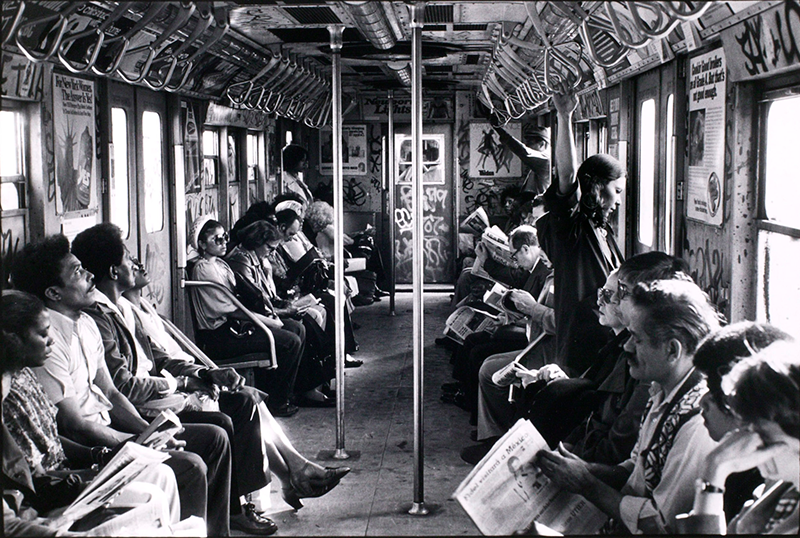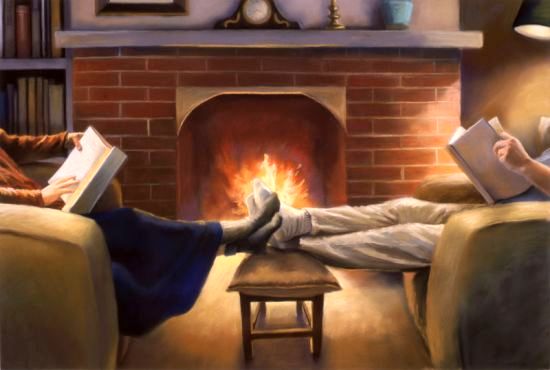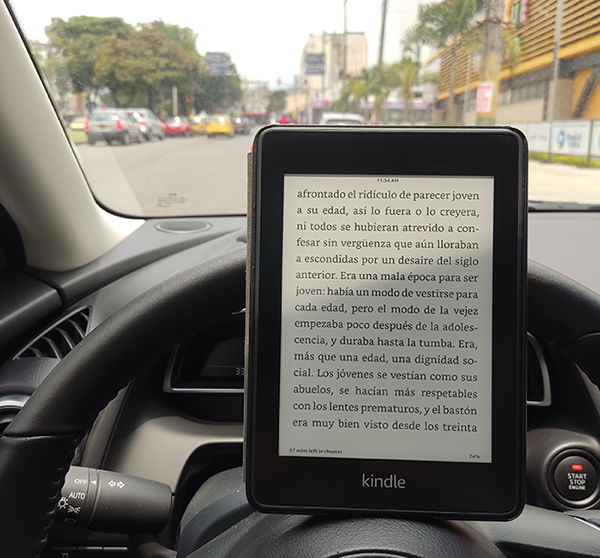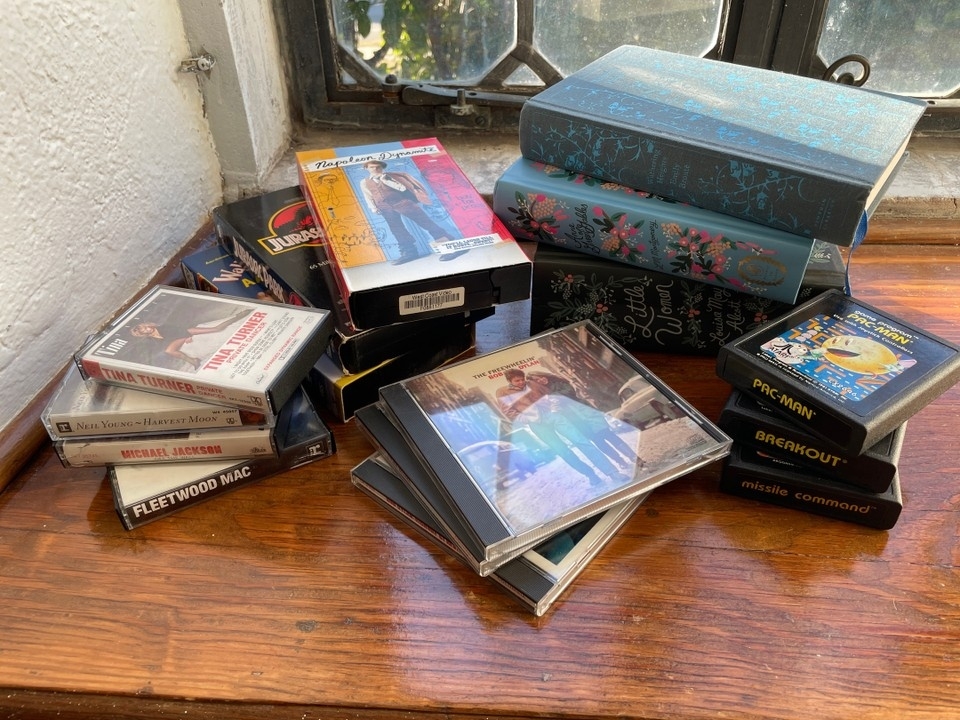When you look at photos of people in public years ago, you see them looking at books, magazines, and newspapers. They are reading in the spare moments. Here is a photo by Danny Lyon from 1979:

The procurement, consumption, and maintenance of physical media used to be such a big part of our lives. What is “physical media”? Books, DVDs, magazines, CDs, newspapers, records, and the like. For much of my life, my biggest hobby was searching out music, scouring record bins for rare pressings, making long drives out to records stores I had never been to.
But now, I just open Spotify.
How people read and listen and watch has evolved a lot in the past decade. In the work I do of helping writers share their work, today I want to reflect on the pros and cons of physical media, and how that helps us understand reader behavior.
The Experience of Books and Art
How someone experiences your book is multifaceted. As the author, you can put what you want on the page, but the reader brings themself to it as well. They are reading your words through the lens of their life. I don’t think there is one clear split, but a simplistic way to say it is the book is 50% the author and 50% the reader. Of course, that can change line by line for each and every reader throughout the book. I mean, just this week I was reading a book and didn’t even register what I had read on a page because I was daydreaming. So I “read” the book, but not page 337. Other times, I am deeply immersed in what the the author is presenting. Our experience of books and art is infused within the rest of our lives. We multitask. We read while three other things are happening around us. Between activities. A few pages at a sitting, each a different time of day, a different mood, a different climate.
Sometimes it does look like this image from a painting by Deborah DeWit:

But sometimes it looks like this (from Reddit user @sgewux):

The Ownernship of Media
Recently I’ve been thinking about physical media; how we can own a copy of the books, movies, music, and video games that we love. I’m trying to look beyond sentimentality, although I have plenty of that. Ownership of media can at times be a reflection of how we craft our identity. I remember years ago people visiting my home and spending time looking through my music or books to get a sense of my interests and taste. But I’ve also been considering the qualitative difference that physical media can offer.
Streaming what we listen to and watch and read has compelling features, most notably convenience. Instant access to thousands of titles. You don’t have the cost of ownership with streaming, and perhaps even more importantly: you don’t have to dust a DVD every week that you haven’t watched in more than five years.
Yet with physical media, there are benefits. Here is some physical media at my studio: cassette tapes, VHS taps, books, CDs, and video game cartridges:

When I own a physical copy, I can choose what movie to watch without having to make a financial transaction of renting it digitally. I don’t have to spend time searching around to see what streaming services it is available on for free. I don’t have to worry about a 48 hour time limit on a streaming rental. But even more, physical media can at times offer a higher quality of experience. For movies this may mean visual quality or audio quality. Streaming can offer very high quality movie experiences. But by and large, a 4k blu ray disk offers better.
There are other benefits: for a personal collection of books, one can feel surrounded by the stories that inspire them. They can access them on a whim. They can feel that the physicality of these books help craft their identity and even decorate their home. In many ways, the art and stories and music we consume are the fabric of our lives. And physical media can remind us of this.
Creating a Haven for Immersive Experience
I’ve been thinking about how I can be more intentional in how I experience books, movies, and music. I’ve written previously that I used to have an entire room dedicated to listening to music. But that was a long time ago, and yes, before children.
My family hasn’t owned a TV in something like 15 years. Which means my kids have grown up entirely in a house without one. Of course, I have watched movies or even shows at home in that time, but it was always on the computer. And to be honest, mostly in a very small window on the screen, using the tiny computer speakers for all of the audio.
I’ve been considering how can I more often create an experience I love: the feeling of walking out of a movie theater, as if waking up from a dream. Being reminded of reality and emerging into the real-world still in the fog of whatever fantasy world that immersed me in that theater. So I’ve been creating a small home theater. I mean, I’m sure it’s pathetically common compared to what you have in your living room, but for me, this is a retreat for losing myself into the dreamworld of movies, and of course in sharing that experience with my family.
So I rearranged a room in our home — not the living room — but a much smaller more private room. I bought a TV for the first time in a long time, got a surround sound system and some new furniture. And now, I’m buying physical copies of movies. It feels old fashioned. To spend $12 or $25 on a movie that I now have to dust. I’m asking myself, how many times will I really watch this movie in the next five years?
But that is compared to what I’m truly buying: an immersive experience to lose myself in a movie. To close the shades, turn off the lights, close the door, turn the volume way up, and dive into a film.
So many writers I speak to barely have time to read, or don’t even read within the genre or topic they write. That is, of course, a choice that each of us get to make. But I would encourage you to consider the experience of what it means to read, listen, and watch. What are the qualitative factors that change how immersive it is for you? How do your ideal readers make these same decisions?
I’m curious: how do you feel about physical media? Books vs ebooks? A movie you hold in your hand vs one you stream? A physical copy of an album vs pressing ‘play’ on Spotify? Which do you prefer, when, and why?
Thanks.
-Dan
